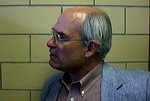All is not lost however. Some results have stood the tests of time and of multiple replications. While the examples to follow fail to reach the criterion of a scientific law they serve to illustrate real and reliable psychological data. The first example is Ebbinghaus’ research on human memory. His 1885 book, Über das Gedächnis (Concerning Memory) caused a sensation when first published. He was the first to show the relationship between memory and the passage of time. Simply put, we forget much more quickly soon after learning and forget much more slowly thereafter. The figure below shows the relationship between memory and time.
 Ebbinghaus’ discovery does not rise to the level of a scientific law because other conditions (e.g., practice) can alter the relationship between memory and time. So, the relationship is real and reproducible but it does not apply to all types of memory. A second example is Shepard and Metzler’s (1971) mental rotation research. In a laboratory setting, they projected pairs of geometric stimuli to human participants. While the stimuli were projected in two dimensions, they were designed to convey information in all three dimensions. Participants had to decide quickly whether the two stimuli were alike or different. The stimuli which were alike were presented from 0° up to 180° of rotation from each other in any plane. Like Ebbinghaus, they discovered a remarkably straightforward relationship between the amount of rotation and the time it took to decide. As the rotation approached 180°, participants took longer to decide. Moreover, the relationship was linear. See the figures below for examples of the stimuli used and the results Shepard and Metzler found. Pigeons, too, have been tested for their abilities to
Ebbinghaus’ discovery does not rise to the level of a scientific law because other conditions (e.g., practice) can alter the relationship between memory and time. So, the relationship is real and reproducible but it does not apply to all types of memory. A second example is Shepard and Metzler’s (1971) mental rotation research. In a laboratory setting, they projected pairs of geometric stimuli to human participants. While the stimuli were projected in two dimensions, they were designed to convey information in all three dimensions. Participants had to decide quickly whether the two stimuli were alike or different. The stimuli which were alike were presented from 0° up to 180° of rotation from each other in any plane. Like Ebbinghaus, they discovered a remarkably straightforward relationship between the amount of rotation and the time it took to decide. As the rotation approached 180°, participants took longer to decide. Moreover, the relationship was linear. See the figures below for examples of the stimuli used and the results Shepard and Metzler found. Pigeons, too, have been tested for their abilities to

mentally rotate objects. Unlike humans, pigeons are able make accurate mental rotations from various points of view (Köhler, Hoffman, Dehnhardt, & Mauck, 2005). Humans perform mental rotations best while in a normal, upright position. Pigeons, on the other, hand perform mental rotations equally well regardless of their spatial relationship to the stimulus. Flying, apparently, affects how pigeons make mental rotations. Thus, the results show that different species make mental rotations differently. Again, while the results of mental rotation experiments are replicable, they are not universal. The species tested makes a difference.
References
Köhler, C., Hoffmann, K. P., Dehnhardt, G., & Mauck, B. (2005). Mental rotation and rotational invariance in the rhesus monkey. Brain, Behavior, and Evolution, 66(3), 158-166.
Merton, R. K. (1949). Social theory and social structure. Glencoe, IL: Free Press.
Mjøset, L. (2001). Theories: Conceptions in the social sciences. In N. J. Smelser & P. B. Baltes, (Eds.). International encyclopedia of the social and behavioral sciences. 23, 15,641–15,647.
Shepard, R. N., & Metzler, J. (1971). Mental rotation of three-dimensional objects. Science, 171(3972), 701-703.



